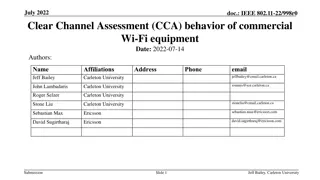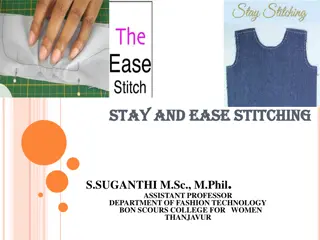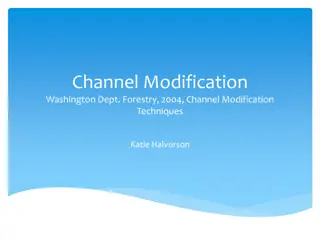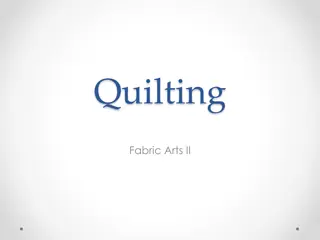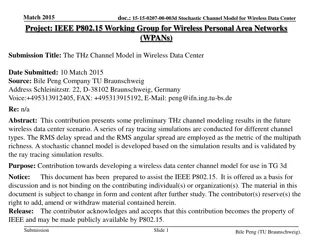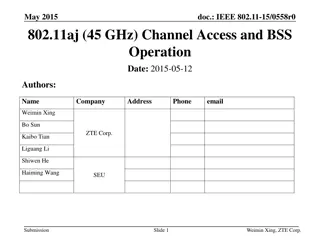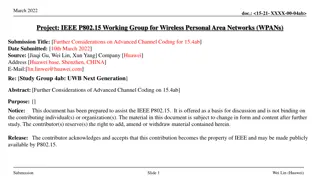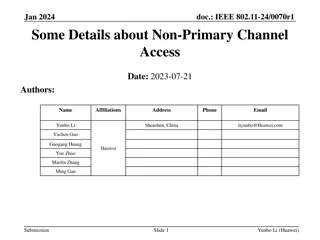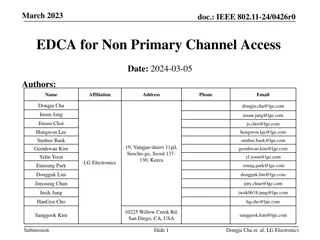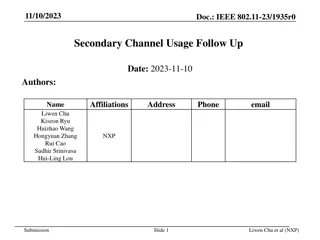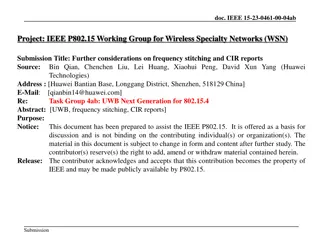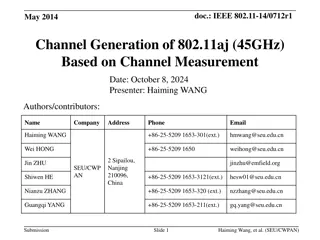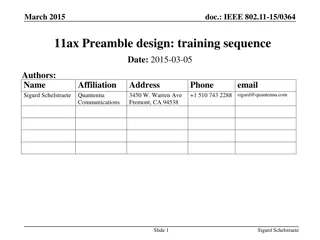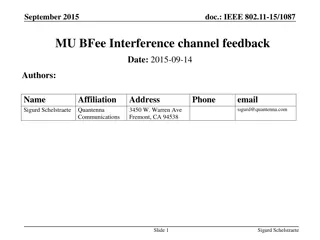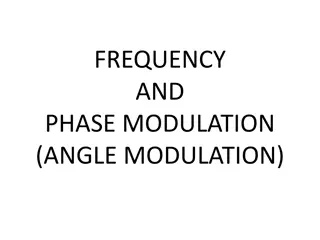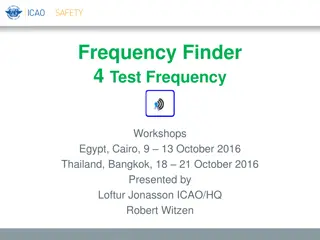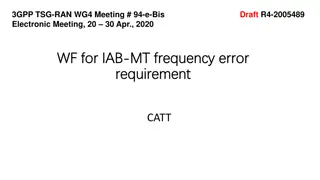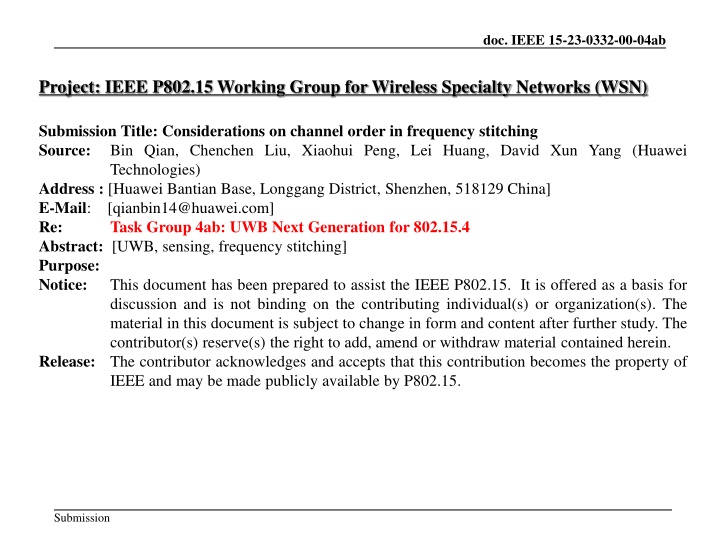
Considerations on Channel Order in Frequency Stitching for Wireless Specialty Networks
Exploring the implementation of different channel orders in frequency stitching for improving wireless specialty network performance. The document outlines solutions to interference mitigation, coexistence improvement, enhanced ranging capabilities, and more. It emphasizes the enhancement of accuracy, reliability, interoperability, and power efficiency in high-integrity ranging applications, along with support for various streaming and connectivity protocols.
Download Presentation

Please find below an Image/Link to download the presentation.
The content on the website is provided AS IS for your information and personal use only. It may not be sold, licensed, or shared on other websites without obtaining consent from the author. If you encounter any issues during the download, it is possible that the publisher has removed the file from their server.
You are allowed to download the files provided on this website for personal or commercial use, subject to the condition that they are used lawfully. All files are the property of their respective owners.
The content on the website is provided AS IS for your information and personal use only. It may not be sold, licensed, or shared on other websites without obtaining consent from the author.
E N D
Presentation Transcript
doc. IEEE 15-23-0332-00-04ab Project: IEEE P802.15 Working Group for Wireless Specialty Networks (WSN) Submission Title: Considerations on channel order in frequency stitching Source: Bin Qian, Chenchen Liu, Xiaohui Peng, Lei Huang, David Xun Yang (Huawei Technologies) Address : [Huawei Bantian Base, Longgang District, Shenzhen, 518129 China] E-Mail: [qianbin14@huawei.com] Re: Task Group 4ab: UWB Next Generation for 802.15.4 Abstract: [UWB, sensing, frequency stitching] Purpose: Notice: This document has been prepared to assist the IEEE P802.15. It is offered as a basis for discussion and is not binding on the contributing individual(s) or organization(s). The material in this document is subject to change in form and content after further study. The contributor(s) reserve(s) the right to add, amend or withdraw material contained herein. Release: The contributor acknowledges and accepts that this contribution becomes the property of IEEE and may be made publicly available by P802.15. Submission
Slide 2 doc. IEEE 15-23-0332-00-04ab PAR Objective Safeguards so that the high throughput data use cases will not cause significant disruption to low duty-cycle ranging use cases Interference mitigation techniques to support higher density and higher traffic use cases Other coexistence improvement Backward compatibility with enhanced ranging capable devices (ERDEVs) Improved link budget and/or reduced air-time Proposed Solution (how addressed) Additional channels and operating frequencies Improvements to accuracy / precision / reliability and interoperability for high-integrity ranging Reduced complexity and power consumption Hybrid operation with narrowband signaling to assist UWB Enhanced native discovery and connection setup mechanisms Sensing capabilities to support presence detection and environment mapping Low-power low-latency streaming Higher data-rate streaming allowing at least 50 Mbit/s of throughput Support for peer-to-peer, peer-to-multi-peer, and station-to- infrastructure protocols Infrastructure synchronization mechanisms Different channel orders in frequency stitching Submission
July 2023 doc. IEEE 15-23-0332-00-04ab Reference [1] IEEE 802.15/22-061r0, Sensing Continued [2] IEEE 802.15/22-422r0, UWB Sensing - Scheduling [3] IEEE 802.15/23-178r0, Frequency Stitching Considerations [4] IEEE 802.15/23-284r0, Latest Consensus on UWB Sensing PHY and MAC Submission Slide 3 Bin Qian, Huawei
July 2023 doc. IEEE 15-23-0332-00-04ab Recap: Frequency Stitching The frequency stitching is discussed in [1-3] to improve the effective bandwidth of sensing by aggregating multiple frequency segments together. Two factors are considered further in the frequency stitching Time scale. The time to obtain each measurement of frequency stitching should be less than the coherent time of the channel. Short total time span per measurement is good. Transmission power loss. Overlap between adjacent used channels may lead to mean EIRP accumulation when minimizing the total time span, which may result in transmission power loss. Small transmission power loss is good. Submission Slide 4 Bin Qian, Huawei
July 2023 doc. IEEE 15-23-0332-00-04ab Recap: Channel Order in Frequency Stitching Two types of channel order in frequency stitching In-sequence channel order: shorter total time span, possible transmission power loss Out-of-sequence channel order [3]: longer total time span, no transmission power loss Out-of-sequence channel order In-sequence channel order Submission Slide 5 Bin Qian, Huawei
July 2023 doc. IEEE 15-23-0332-00-04ab PSD Accumulation The channel overlapping in frequency stitching could be 124.8 MHz (25% overlap), 249.6 MHz (50% overlap), and 374.4 MHz (75% overlap). Different overlaps leads to different PSD accumulation result Sensing pulse shape: the time-bounded Kaiser with 3 chips [4] 25% overlap 50% overlap 75% overlap Submission Slide 6 Bin Qian, Huawei
July 2023 doc. IEEE 15-23-0332-00-04ab PSD Accumulation (Cont.) For 25% overlap, the PSD accumulation will not exceed 0 dBr. In-sequence channel order will achieve short total time span and no transmission power loss simultaneously For 50% overlap, the maximum value of PSD accumulation is about 1 dBr. In this case, in-sequence channel order may have 20% transmission power loss For 75% overlap, the maximum value of PSD accumulation is about 3 dBr. In this case, in-sequence channel order may have 50% transmission power loss Submission Slide 7 Bin Qian, Huawei
July 2023 doc. IEEE 15-23-0332-00-04ab Possible Solution In [3], there is an one-to-one mapping between the overlap factor (OF) and overlap rate as follow (No overlap, 0), (25% overlap, 1), (50% overlap, 2), (75% overlap, 3) The out-of-sequence channel order could be computed according to CH((p*(OF+1) MOD (N)) + (p*(OF+1) DIV (N))), where p = 0 ... (N-1) and DIV denotes integer division When the out-of-sequence channel order is used, we propose to change the value of overlap factor as follows Overlap Factor (OF) Value Description 0 Non-overlapping, 25% overlap 1 Reserved 2 50% overlap 3 75% overlap Submission Slide 8 Bin Qian, Huawei
July 2023 doc. IEEE 15-23-0332-00-04ab Summary Based on the observations of the PSD accumulation, the out-of-sequence channel order does not bring any benefit under 25% overlap We suggest that the in-sequence channel order shall be used for frequency stitching under 25% overlap Whether the in-sequence channel order or the out-of-sequence channel order is used for frequency stitching depends on the tradeoff between the time span per measurement and the transmission power loss under 50% overlap and 75% overlap Submission Slide 9 Bin Qian, Huawei
July 2023 doc. IEEE 15-23-0332-00-04ab Thank You Submission Slide 10 Bin Qian, Huawei




